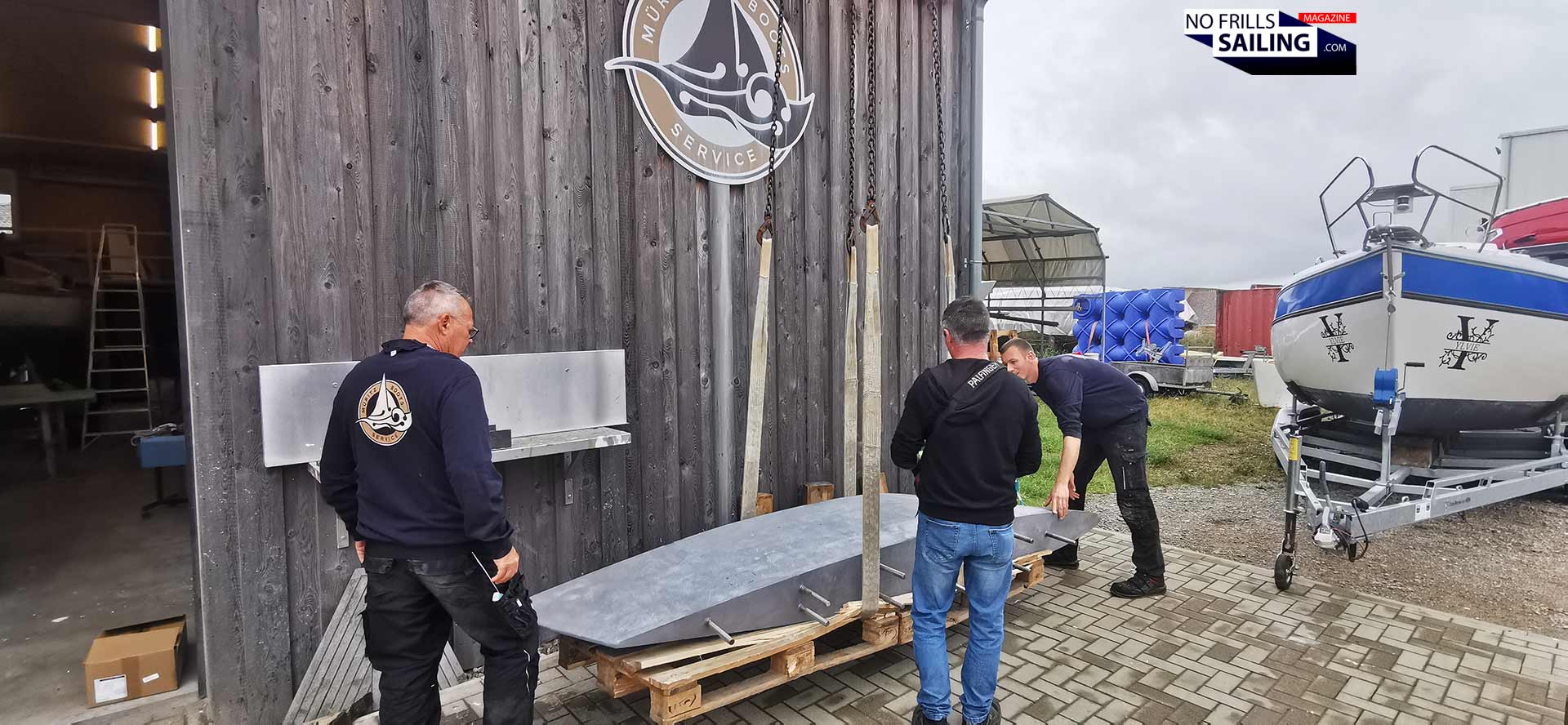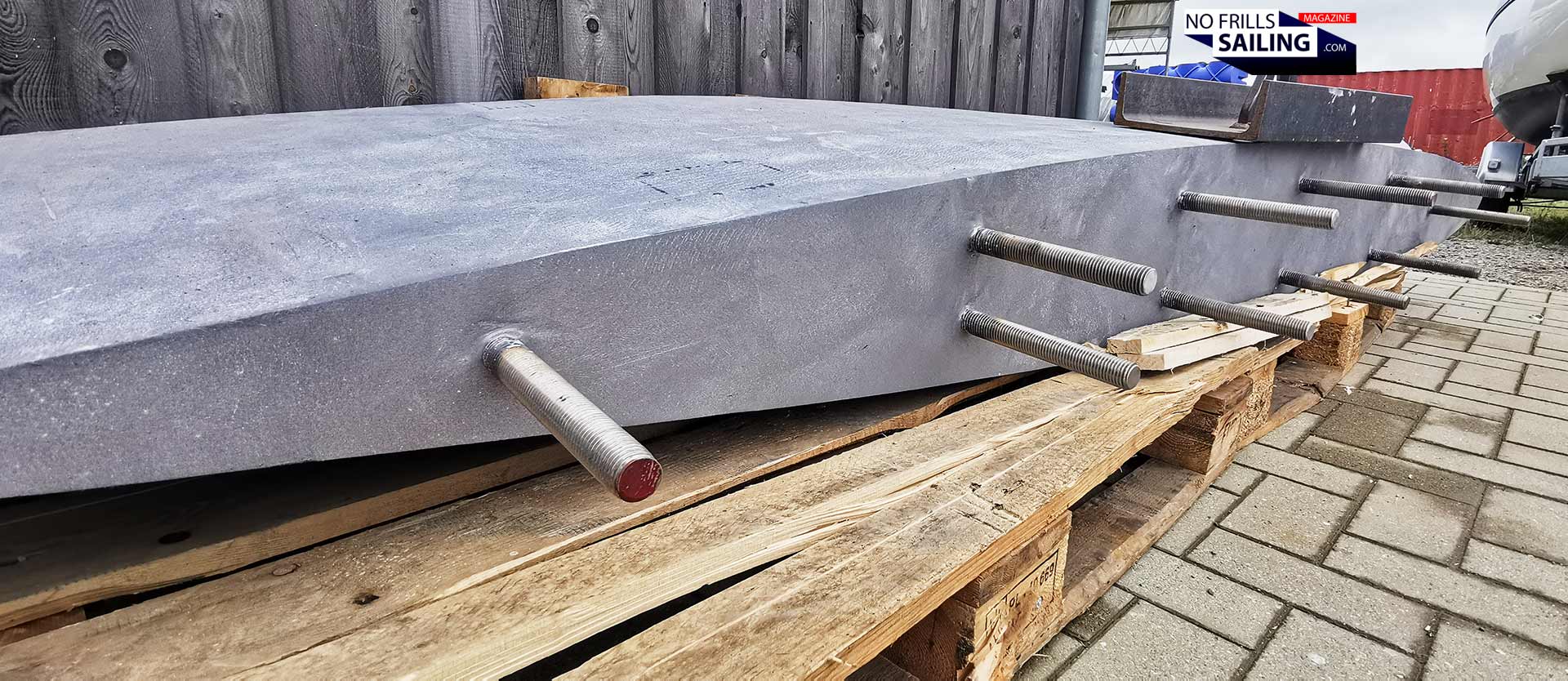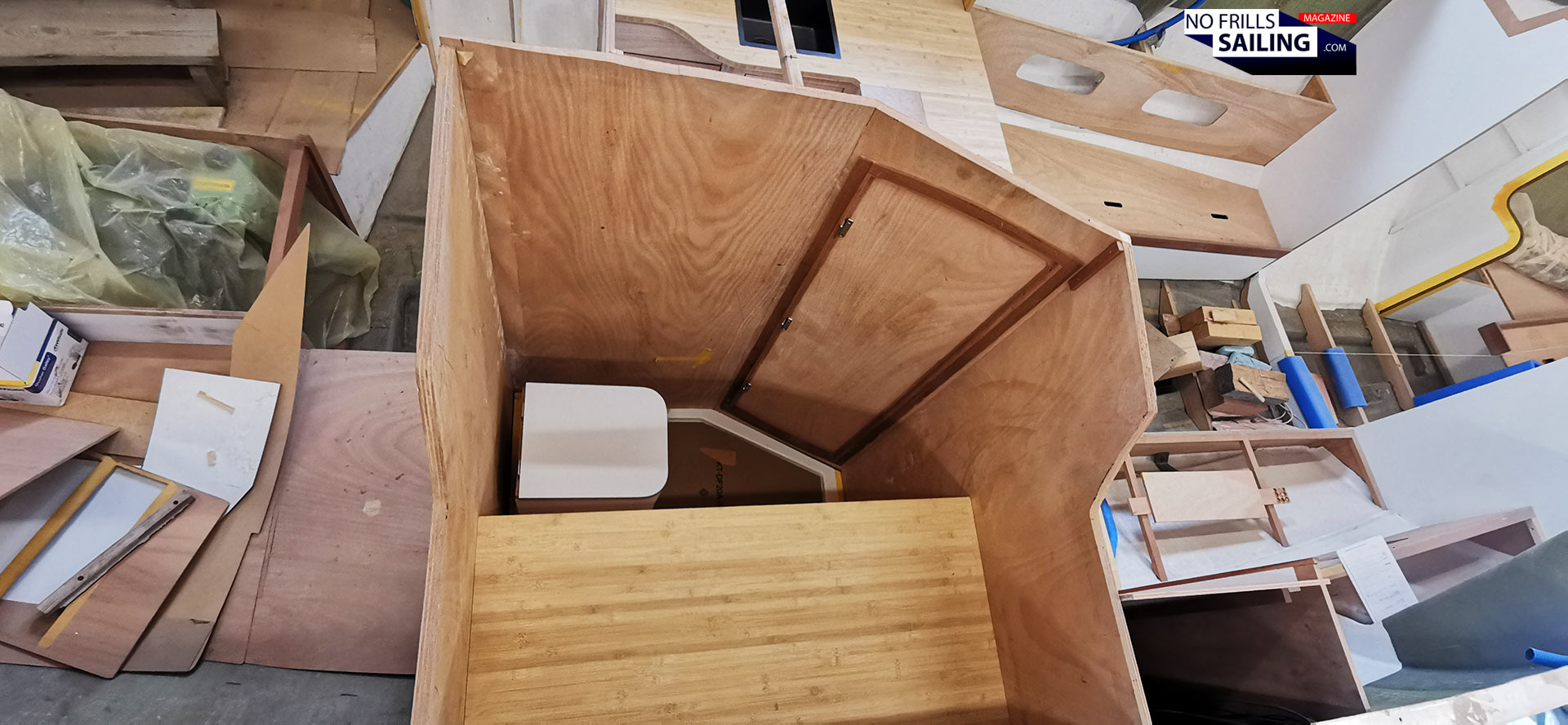There are a few certain occasions during a boat´s construction which kind of stick out: Very important steps of production, dates to be remembered. Last week was one of those. For me maybe a bit more important as the backstory of how the keel of my new Omega 42 came into existence is a bit special compared to, let´s say, an ordinary production cruiser. The day before delivery my shipyard called me: “The truck has arrived today, tomorrow at 10 a.m. we will unload. Wanna join?” What a question, of course want I join!

The materialization of the keel for my new sailing yacht is more than a nice side-story of the building of that boat. You may have read the articles about this particular part of the boat – finding a foundry where the keel could be cast alone was an adventure. It took me (or them) three months to cast it and seven more until it was ready for shipment. Wow. So, when I arrived at the shipyard I was stunned: A large beautiful red truck parked on the premises, it´s side opened already. What a big lorry to transport such a small item, you might think. Well … that´s the one amazing detail about a sailboat´s keel: It´s not any ordinary freight.
The insane logistics of a keel transport
The keel for my Omega 42 weighs in at 3.7 tons. That´s the exact weight its designer, unforgotten Swedish legend Peter Norlin has calculated for the boat´s ballast. Concentrating a large mass like this into such a small part means that the keel – as big as it is in terms of its measurements – could become a very dangerous, virtually unstoppable cannonball on the roads if something happens. So securing it (to a certain specific location on the truck´s load floor) is paramount.

I guess this is the reason why the casting house has sent such a huge truck and not a small, shaky or instable box wagon. The distance from the foundry in the middle of Germany to the shipyard is about 650 kilometers. I asked the driver if he´d come with that huge truck exclusively for my keel alone, which, to my relief, he said wasn´t the case: For once, I could´t pay an “empty” truck for an exclusive transport that far and secondly, 4 tons of load only and still leaving so much volume free for other stuff to transport would be stupid. So, I was a bit eased. Nevertheless, it became a bit complicated.

Because just to load and unload this massive piece you need forklift trucks capable of moving such a weight. No chance for your usual vehicle fleet. Back at the foundry they have those things, but not here at the shipyard: The delivery of such a heavy item is a rare occasion. So a second truck with a crane was rented for this operation. It moved the keel out of the big delivery truck and loaded the keel onto its back. Then the truck drove a dozen or so meters right in front of the big entrance to the building shed for unloading.
3.7 tons of massive lead up in the air …
It was such a marvelous sight to see this massive thing being lifted high up into the air by the crane. Very cautiously, centimeter by centimeter, the crane operator raised it. It´s weight was so high that the two wooden transport pallets apparently broke here and there under it´s 3.700 kilograms. Very, very slowly the keel increased its height, just to be swung around. Again … very cautiously.

I couldn´t stop but imagine what would happen if one of the thick belts would rip or the shackle give in. 3.7 tons plunging down would easily destroy the frame of the truck. Or crush a human. Of course it´s considered bad luck (and violates any work-safety rules) to walk underneath floating loads, and nobody dared to. Slowly, the keel sank down where two workers grabbed it and gently turned it into the right position. Albeit being that heavy, I was fascinated by it´s sharp, elegant and sleek design. And I was happy: Finally the keel is here! Also, the keel´s gauge model needed to make the casting mould has been sent back, which we also unload.

To my knowledge there are only three foundries specialized in lead casting left over in Europe: One in Poland, one in the United Kingdom and one in Germany. Getting it from the UK makes no sense for me as transport-distance and the Brexit-connected paperworks would have made it far too expensive. I asked for a quote in Poland, but communication turned out very tedious and “strange” – being German myself, of course, all was on “go” to have my keel cast in my own country. Which was an adventure in itself as well …
Before the keel can be attached
I am very sad that I could attend the casting process, which certainly would have been a huge highlight. Due to work-safety rules (lead is a very hazardous heavy metal) this was impossible. The guys did not take any pictures so that I cannot show you how it works: Maybe because they don´t want to show? This foundry works for Y-Yachts, partially X-Yachts and some other high-class brands, especially in the one-off and luxury sailboat branch. Maybe that´s the reason. Anyways, that way I can be sure that this piece of metal has been produced with utmost care and competence.

As the crane operator put the keel to it´s provisionary resting place, I ask the Jonas, master boatbuilder for my project, what the next steps regarding this item would be. When the time is right – and this will be in a few months – they will prepare the keel for mounting. As lead is a poisonous material, it must be sealed off. That said, the guys will properly sand and level the keel´s surface, achieving a perfect symmetry. Irregularities will be treated with fillers: The aim is to achieve a perfect smooth part.

Then it will be covered with multiple layers of GRP to form a permanent barrier between the lead and the water. We do not want to poison the little fishes swimming around the Omega … After this, and this will be one of the very last production steps, probably done when everything else is finished and the boat is a week or so away from delivery, the keel will be mounted underneath the hull in a “bed” of pure Epoxy. But that´s still a way to go. For now, it remains at the shipyard´s entrance, acting a bit like these proud guardian lions flanking the way to the King´s palace …
A project on schedule
I am so much looking forward to the day when the keel will be attached! But, as I stated at the beginning of this article, just having it here at the shipyard now is a big-time relief and makes me proud. The keel is, apart from the hull and the rigging, the single biggest item on the to-do-list of any sailboat. And as it is the keel which brings stability, pointing capabilities and the individual steering character to the boat, it´s one of the most deciding items. Keel design and its influence on how the boat will behave (or not) is often overlooked and sometimes even neglected. But in reality naval architects invest a lot of effort into their shapes and properties. The Omega 42´s keel is very special too, it will be the strong backbone of my ALPHA.

But why did it take so long to make, you might ask. Well, for most part it´s a question of money. Lead, not unlike Gold or other precious materials, is subject to ever changing prices as it is traded at the big commodity markets. That means lead has a kind of “volatile” day price. It can go up and down very vividly, making large jumps price-wise either in the higher or in the lower direction. I am not a millionaire, apparently, and so I´ve asked the foundry to only take action when the price is “down”: This is the reason why I started the keel-project so early in the production process. Because, if I hadn´t and the boat would have been finished, I would have had to pay the price that lead had that day. Now, wit so much lead-time, the buying agents at the casting house were able to wait and hit the “buy button” when price was acceptable.

That said, what was the price in the end? Well, all in all, it´s mounting to some 25.000 Euros for this keel to be cast, treated and delivered. It´s funny: Talking to Stefan, owner of the first Omega 42 WINDFAENGER, his keel was roughly 10.000 Euros less – this is what 7 years of surging energy prices and high inflation do! But as we cannot do anything about it, this was my only strategy to not fully rape my budget. Anyway, with finishing the yacht the boatbuilders are on schedule, they are working mostly on the interior and joinery. But that´s stuff for another article – for now, I jumped into my car and drove back home. Happy that this big, heavy, beautiful piece of heavy metal is now where it belongs. What a great feeling!
Found it interesting? Here are some more articles on sailboat keels:
Clever keel: How sailing yacht´s ballast can be mounted underneath
What it takes to professionally mount a keel
Appendages design iterations and how keel shapes influence a boat
